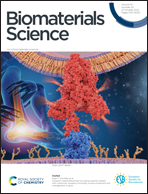High-performance bilayer composites for the replacement of osteochondral defects
Abstract
Osteochondral (OC) defects combine damage to cartilage and subchondral bone, posing a significant challenge to their repair due to the dissimilar characteristics and regenerative capabilities between the two tissues. Here, we propose novel OC bilayer composites, drawing inspiration from corresponding biological tissues and using a combination of simple and reproducible techniques. Cartilage-like materials based on poly(vinyl alcohol) (PVA) hydrogels were produced with nanofiber reinforcements acquired from high-performance fibers (Kevlar® and Zylon®), while bone-like materials were obtained by adding magnesium-substituted calcium phosphate ceramics to PVA. All composites were sterilized by gamma irradiation to rule out the possibility of undesirable effects resulting from the process, and then fully characterized. The results indicated that nanofibers and bioceramics incorporated into the PVA networks form promising structures with multiple interesting properties. The composites resembling cartilage and bone showed high biomimicry with natural tissues, being able to reconcile exceptional mechanics with the requirements of adequate porosity, liquid content, and biological behavior. The developed materials reveal a high potential for use in OC tissue repair applications.

- This article is part of the themed collection: 31st Annual Conference of the European Society of Biomaterials


 Please wait while we load your content...
Please wait while we load your content...